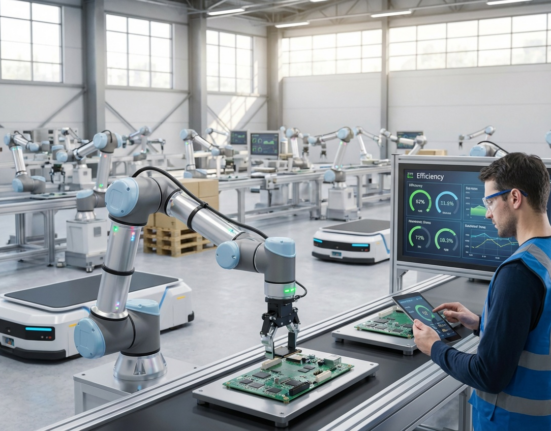Introduction: Why Skills Matter in Collaborative Robotics
Collaborative robots, or cobots, are transforming industries from manufacturing to healthcare. Yet technology alone isn’t enough. The true success of cobots depends on people. Developing the right collaborative robotics skills ensures smooth integration, greater efficiency, and confident workers who embrace change rather than resist it.
Understanding Collaborative Robotics Integration
Integration is more than plugging in a machine. It’s about ensuring cobots and humans work together safely, efficiently, and productively.
Core Collaborative Robotics Skills Every Workforce Needs
1. Programming Basics
Workers must understand simple coding or drag-and-drop interfaces to assign tasks.
2. System Integration
Employees should know how to connect cobots to sensors, conveyors, and other machines.
3. Safety Protocols
Understanding safety standards ensures cobots operate without risk to humans.
4. Troubleshooting
Quick problem-solving skills prevent downtime and maintain productivity.
5. Data Literacy
Cobots generate data — workers must analyze it for continuous improvement.
Advanced Collaborative Robotics Skills
Machine Vision
Skills in setting up cobot vision systems enable precision in assembly and inspection.
Human-Robot Interaction (HRI)
Workers must learn how to adapt workflows for seamless cooperation with cobots.
Maintenance Expertise
Upskilled employees can perform preventive maintenance to extend cobot life cycles.
AI & Machine Learning Awareness
Understanding how cobots learn helps workers optimize future applications.
Soft Skills for Collaborative Robotics Integration
Adaptability
Embracing change ensures smoother transitions during cobot adoption.
Problem-Solving
Employees must think critically when cobots encounter unexpected challenges.
Team Collaboration
Cobots succeed when people across departments collaborate effectively.
Communication Skills
Clear communication between workers, engineers, and managers ensures alignment.
Training Programs That Build These Skills
Universal Robots Academy
Offers free online cobot training with interactive modules.
FANUC Robotics Training
Focuses on real-world programming and safety practices.
KUKA College
Provides advanced integration and system design courses.
ABB Robotics Training
Covers safety standards, troubleshooting, and deployment strategies.
Challenges in Developing Collaborative Robotics Skills
- Resistance to new technology.
- Limited training budgets.
- Gaps in technical knowledge.
- Balancing training with day-to-day responsibilities.
Best Practices for Building Workforce Skills
Start with Foundational Training
Teach safety and programming basics before moving to advanced topics.
Encourage Hands-On Learning
Practical sessions make skills stick faster than theory alone.
Promote Continuous Upskilling
Regular refreshers ensure workers keep up with evolving cobot technology.
Measure Success
Track efficiency, safety incidents, and employee confidence after training.
Industries Leading in Collaborative Robotics Skills Development
Manufacturing
Auto plants train workers to oversee cobot-driven assembly.
Healthcare
Hospitals equip staff to handle cobot-assisted sterilization and surgery prep.
Logistics
Warehouses upskill teams to work with cobots in picking and packing.
Future Trends in Collaborative Robotics Skills
Blended Learning Models
Combining virtual and in-person training.
Simulation-Based Training
Virtual labs reduce costs and allow safe practice.
AI-Powered Training Tools
Adaptive platforms tailor training to each learner.
Global Certifications
Standardized credentials will validate workforce expertise worldwide.
Conclusion: Skills Build the Bridge to Success
Collaborative robotics skills are the foundation of smooth integration. By investing in both technical and soft skills, companies unlock the true value of cobots — safer operations, higher productivity, and a workforce ready to innovate.
FAQ
1. What are collaborative robotics skills?
They include technical, safety, and soft skills needed to integrate cobots into the workplace.
2. Why are these skills important?
They ensure safe, efficient, and innovative collaboration between humans and robots.
3. What training programs teach collaborative robotics skills?
Universal Robots Academy, FANUC, ABB, and KUKA offer leading programs.
4. Which industries benefit most from developing these skills?
Manufacturing, healthcare, and logistics are leading adopters.
5. How can companies encourage skill development?
By offering continuous training, hands-on practice, and clear communication about benefits.








